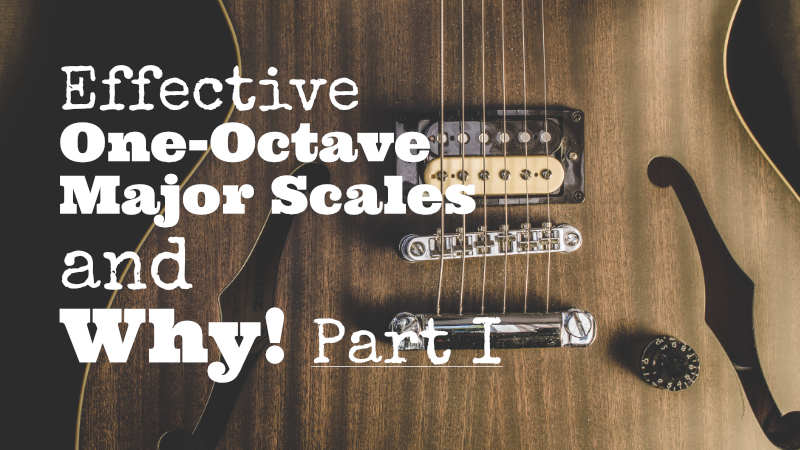October 4, 2020 by Klaus Crow

When you learn your first scales you usually start with two-octave scales, because they span all six strings of the guitar. You play from the Low E-string all the way up to the high e-string.
That’s great! It’s important you learn the two-octave scales inside out, but one-octave scales have their own effective purpose that will serve your playing in a different and complementary way.
Why You Want to Learn One Octave Scales
One of the reasons you want to learn one-octave scales is because of their simplicity. By using only one octave it’s easier to see the shape and structure of the scale, the notes within the scale, and the intervals. The scale is more user-friendly, easier to play, memorize and apply around the fretboard.
There’s another great benefit to learning one-octave scales. Once you got them under your fingers it’s only a matter of connecting the dots to lay out two octave and three-octave scales, since they are made up of one-octave scales.
Note: This post is part of a small series where you will learn one-octave major scale shapes across the entire guitar neck that will help you understand and own the major scale landscape.
Starting from the Root Note on the Low E-string
Today we’re learning three major scale shape/patterns with the first (root) note starting on the Low E-string (6th string).
Tip: For this lesson learn and memorize the notes on the low E-string so you know and recognize the key of the scale when you want to move the scale up or down the fretboard.
Major Scale Fingering
For the major scale examples and tablature below I’ve notated the left hand fingering (for right handed players). The numbers next to the notes on the note staff right above the tablature indicates the left hand fingers:
1 = index
2 = middle finger
3 = ring finger
4 = pinky
The numbers in the yellow neck diagrams also indicate the fingers. The neck diagrams also clearly show what the shape or pattern looks like. Learn to visualize and memorize the shape of each pattern.
Alternative Picking
Make sure you play the scale shapes using alternative picking. Hold the pick between your thumb and index finger with the pointed end facing toward the strings. Strictly use alternating down and up strokes. The first note you play is a downstroke, the second an upstroke, the third one a downstroke, the fourth one an upstroke and so on.
Key of the Scale
In the examples below we play the G major scale, but it’s the goal to learn these scale shapes/patterns in every key.
Now let’s get to practice!
MAJOR SCALE SHAPES – ROOT NOTE STARTS FROM THE 6TH STRING
G MAJOR SCALE SHAPE / PATTERN #1


First learn and memorize major scale pattern #1. Once you got the scale under your fingers learn the pattern in different keys. Move up the entire scale shape 2 frets higher (that means every note of the scale) and play it again. Your first (root) note should now be starting on the 5th fret Low E-string. You are now playing an A major scale. Now play the scale starting with the first note on the 8th fret. You’re playing a C major scale. Learn the skill of playing your scale everywhere on the neck.
G MAJOR SCALE SHAPE / PATTERN #2


Major scale pattern #2 needs a little bit of a stretch which might seem challenging in the beginning, but after some practice you will get the hang of it. This one is really good for cultivating dexterity, and playing 3-notes-per string licks. Again, once you got it under your fingers learn to play this pattern in different keys. When you play this scale pattern higher up the neck it gets the easier, because the spaces between the frets get smaller.
G MAJOR SCALE SHAPE / PATTERN #3


Pattern #3 seems a little bit far up the neck, but the point is to learn and memorize the scale shape/pattern and then play it in different keys around the neck. Example: Play this scale moving down 10 frets, starting with the first (root) note on the 5th fret Low E-string you are playing an A major scale. Now play it on the 8th fret, the 10th fret, 7th fret and 10th fret. This is a great exercise to get comfortable with the entire fretboard and learning to play in different keys and feel free in your playing.
Assignments:
- Learn to play each scale shape /pattern ascending and descending using alternate picking.
- Make sure each notes sound clean and clear.
- Learn to play the scale shapes in different keys and be sure to know what key you’re playing in.
- Play the scale along with a metronome in different tempos.
- Try to create some melody with each scale shape. Experiment with playing notes from the scale in a different order, use rhythm and different note lengths, and pauses. Try to come up with your own melody or play an existing melody you already know. Play around with the notes. It’s such a valuable lesson. Dare to experiment!
Have fun!
In the next post we’re going to learn one-octave scales starting on the A-string. We’re going to master the entire fingerboard. If you got this lesson under your belt check out: Effective One-Octave Major Scales and Why! Part II
This helps a great deal. Looking forward to part II
Ron
Hi Ron,
Part II coming soon ?
Enjoy the lesson.
Klaus thanks for this post.
I’m practicing pattern 2. That’s a big stretch but I’m getting there. Haha!
Cheers, Chris
Hi Chris,
Pattern #2 is like yoga for your fingers.
While it may seem challenging in the beginning your fingers will become much more flexible when you keep practicing the pattern.
Best,
Klaus
I very much appreciate your effort and encouragement. This will keep me preoccupied for sometime. My question is, as an aspiring guitar teacher, should students be introduced to these scales early on in their playing?
I look forward to your reply.
Julius
Hi Julius,
Yeah definitely, I think the one-octave patterns are much more suitable for the beginner guitarist.
I would skip pattern #2 in the beginning because of the stretch.
Once they can play one-octave scales it’s much easier to take on two-octave scales.
Once again Klaus yet another great lesson.
Thanks for everything.
Phil.
Hi Phil,
Thanks I appreciate that.
Have a good guitar practice and a great weekend!
Cheers,
Klaus
This is a great lesson and will practice these shapes thoroughly.
I am much more interested in shapes in the higher register like the first 4 strings where the real soloing takes place….maybe it will be in the next lesson. Thank you Claus for your lessons!
Hi Jay,
We’re going up the strings, one at a time, all the way up the higher register with each upcoming lesson.
Stay tuned. ;)
Best,
Klaus
Hi Klaus,
Your tips help a lot. Thank you for them.
I appreciate all your lessons and e-mails.
Hi Anastasia,
Thanks for being part of the Guitarhabits tribe.
Enjoy the lessons and give it your best!
Best,
Klaus Crow
Awesome looking forward to part 2
Hi John,
Part II is coming soon your way.
Stay tuned! ;)
Hi Klaus,
Great lesson as always. I am eagerly waiting for the next part of the lesson.
Thank you for all the great stuff you post that helps beginners like me.
Hi Pradeep,
Thanks a lot. I’m working on it right now. I had a little setback, because of migraines, but I’m back in the game :)
Part II coming soon!
Dear Klaus,
I am happy with your lessons, even your comments that belong to this lesson immediately assume that this brings me to the next step sooner!
Keep playing acoustically for now and the hobby will only get more fun.
Hi Folkert,
I was so free to translate your comment to English.
Yes absolutely, reading and adding to the comments will speed up the process and get you to the next step sooner ;)
Here’s part II:
Effective One-Octave Major Scales and Why!Part II
Can you recommend some backing track to play along with these patterns?
These patterns make a great practice exercise for all levels of users. Thanks for sharing your thoughts on scales and scale theory.